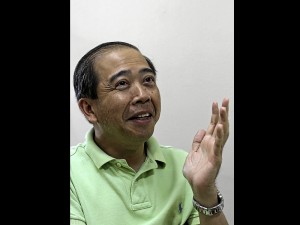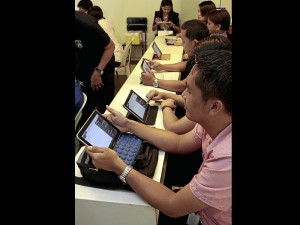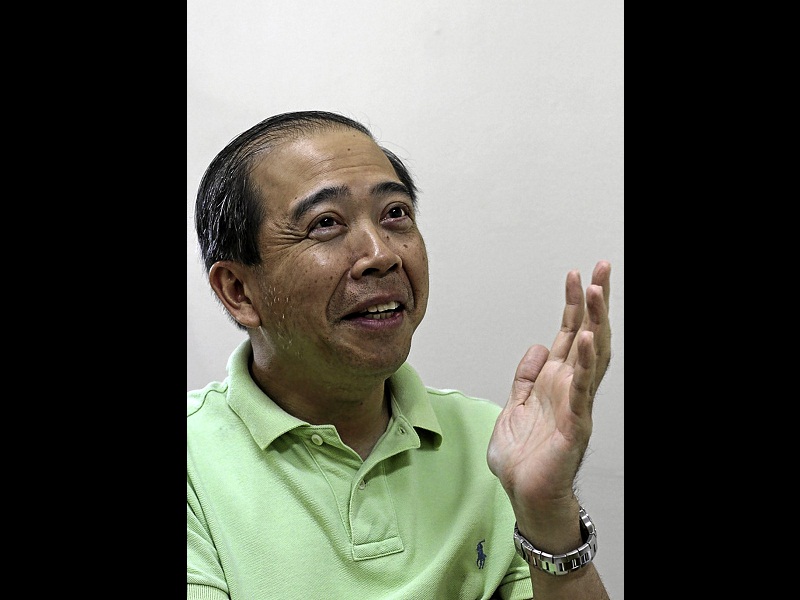
The iPad was a game changer in so many ways. The tablet was a portable medium that can access and store information, images, music, videogames and other apps for various needs, with a battery life that could last all day. With other brands producing their own versions of the iPad, tablet computing is back in a huge and permanent way.
With the tablet becoming indispensable in many trades, it was only a matter of time before they became fixtures in schools.
Putting educational materials into digital form is nothing new. As early as 2002, several schools across the globe have attempted to port these materials into laptop computers. But low battery life and licensing problems stymied the effort.
The tablet though is a different beast—it is more manageable in terms of integration and could be the key to digital consumption in education. As of April 2012, Forbes.com has reported that 2,300 school districts are using the iPad in the classroom, with 600 doing a 1:1 student to iPad program in the US.
The tablet is being touted as the future of education, and in La Salle Greenhills, the future is now.
For project manager Jun Lozada, the motivation to adopt the tablet for classroom use comes from his simple concern as a parent. “My daughter has scoliosis,” he says, adding that the weight of heavy schoolbags could worsen it. A standard school bag for a child weighs anywhere between 10 to 20 kilos—easily the maximum luggage allowance for air travel—which today’s school children cart around or carry on their backs all day.
Lozada knew there was only one solution to this; it was simply a matter of how. He felt that we are once again at the cusp of a revolutionary shift in teaching media, much like that era when Gutenberg introduced the printing press.
After a focus group discussion, the La Salle group concluded that students spend most of their time in front of computer screens, no matter how small, and that they knew how to work the devices. From that, Lozada drew his thesis for this generation: The digital word is their vernacular, and so, in the La Sallian tradition of teaching in the vernacular, why not use this new medium in the classroom?
But what methodology to use? Lozada and his team knew they were exploring new territory. In most schools, the integration of tablets into the curriculum is mainly application driven: Students would have to load reference materials via preexisting applications available on the AppStore or Google Play, which are then used in the school setting.
But La Salle Greenhills’ tablet system was built from the ground up and not based on a preexisting system or template. “We did a system that would allow the school to operate the tablet according to school policy. It’s not technology driving the school; it’s technology enabling the school,” says Lozada.
Ultimately, the tablet as a personal learning device began as a replacement for textbooks. Lozada demonstrates just how interactive a textbook on a tablet could be. Explaining a solar eclipse need not be just about words: Embedded into the text was an animation of a solar eclipse in action, which could be played back over and over.
Before the tablet could be integrated in school though, he had to get parents, school administrators and teachers on board.
“As with every project, I had to burst every bubble that rose to the surface of the water,” Lozada recalls. When it came to addressing the parents’ concerns, safety and security overrode cost. “Once the parents saw the benefits of the tablet, cost became secondary. Safety however remained an issue, so we created a security system that allowed us to secure our devices against theft,” he adds.
The next hurdle was convincing the teachers. “A lot of them were scared of walking into a room full of devices they aren’t familiar with.” He had to stress the importance of being technology-enabled versus technology-driven. “The tablet is very teacher-friendly. It’s the same lesson plan and the same teaching methods; it’s just the medium that’s different,” he says. “Tablets are an appliance working for the students as a personal learning device; for teachers it’s a personal teaching device,” he states.
In fact, the system is designed such that teachers can tell Lozada’s team their specific requirements per subject. A math teacher can request the IT team to disable calculators during class, while another can have the tablet restricted to only display books and deactivate other non-related apps like browsers and Twitter.
Lozada works closely with Samsung, this brand being the tablet of choice in La Salle’s new system. “Samsung had the size I wanted for reading—the 7-inch ones were too small, the 10” was too big; 8.9 was just right and they had it,” he says.
He uses Android’s operating system for the tablets instead of the flashier Apple iOS to pave the way for future plans. It is his goal to one day cascade the tablet and the system they’ve developed to public schools, making digital education accessible to all students.
Asked how much it cost to outfit La Salle with the necessary broadband infrastructure to accommodate the bandwidth needed by more than 4,000 tablets, Lozada demurred. “Just put it this way; this is a self-liquidating project and the IT fees of the kids that go to computers will now also go towards building network infrastructure. Because with one to one computing, students will be the largest per capita consumer of bandwidth now,” he explains.
For a project in its nascent stage, the classroom tablet has already shown a lot of promise. And once teachers, administrators and students get their groove, it’s only bound to get better. “We expect breakthroughs in methodologies, learning and teaching, that’s what we are excited about. We’ve seen how Gutenberg’s printed word unleashed knowledge and learning, and we expect the same thing here.
Once you put the digital word in the hands of teachers and students, sit back and be surprised.” •
After the Storm
Most people remember Jun Lozada for his crucial role in exposing the corruption in the controversial ZTE broadband deal, for which he earned death threat and countless suits. Despite all the aggravation, he’d still join government if given the chance, he says
“WHISTLE-BLOWER” is the one word that best describes Rodolfo Noel “Jun” Lozada. His role in the 2008 NBN-ZTE broadband deal has set off a chain of events that implicated then Comelec Chairman Benjamin Abalos and former First Gentleman Mike Arroyo, President Arroyo’s husband, in acts of corruption.
Lozada’s revelation earned him powerful enemies, to a point that the La Salle brothers and the Association of Major Religious Superiors of the Philippines had to provide him and his family shelter, protection and a temporary home.
From being abducted by government agents who had wanted to silence him, to being hauled in court for various, some say trumped up, charges filed by the Arroyo government, Lozada found himself at the center of a storm. He couldn’t work, and neither could his wife Violet, who used to do a good living selling insurance.
Four years later, with the change in government, the man who was once ordered by his boss to “moderate [the Arroyo administration’s] greed” has yet to recover from his experience with government. True, he’s found a new advocacy-developing the best way to integrate the use of tablets in the school curriculum-but the charges have remained and he still has to attend court hearings regularly.
“I’ve had offers of political asylum abroad but I’m staying. I’d rather face the charges and clear my name,” says Lozada.
Already, his friends in the religious community have approached the Ombudsman and President Aquino to have the charges dismissed, but nothing has changed.
“I can’t move on. Marami pa rin akong kaso, and some of the charges even include my siblings. The cases have become my 88-year-old mom’s source of constant heartache. I’ve filed appeals but all I can do is take comfort in the assurance from some of my friends who say that P-Noy doesn’t break his word.”
The charges range from theft to malversation to graft.
No, he has not countersued the Arroyo allies who gave him aggravation at the Senate hearings and in court. “My personal stand here is, hindi naman ako naniningil [I am not vindictive],” he says.
In fact, given a chance, he’d like to work in government again despite the hellish time he’s had in that sector. He had offers at the start of the Aquino administration, but there was no follow-up, he says. He would have considered them.
“My wife told me, ‘Maybe you’re really stupid,’” says this man who once described himself as a “probinsyanong Intsik [Chinese bumpkin].”
“But I really believe that we can turn this country around and the best way to do that is through governance,” he explains. “I’ve walked the corridors of power and seen how much resources we have—marine, forest, human resources. But why are we still so poor? Because poverty is the consequence of poor governance.”
Besides, he adds, he has received so much support and kindness from fellow Filipinos when life turned awry after his ZTE exposé that he has no recourse but to repay them.
If this means going into politics himself, Lozada says he is also open to the idea. “I had to talk to my wife about it, because she hates this subject. But already, some nuns and bishops have talked to P-Noy to ask him to consider me in the 2013 [line-up of candidates]. Still, I’m not saying yes or no; I’m leaving everything entirely to Providence.”
In the meantime, it’s back to work at La Salle Greenhills, where his is a familiar face cheerfully acknowledged by the school community.
It’s a breeze, Lozada says of his responsibility to digitize education at La Salle. “I’ve been doing IT and education since the early ’90s, so it’s like a vocation for me,” he adds.
He’s already made presentations abroad about this and has so impressed his audience that Samsung recently offered him a post as Education Director for Asia Pacific. He turned the lucrative post down.
“I think people who have not gone through what I have will find it difficult to comprehend my mindset. I have chosen to stay with Philippine schools.”
He’s now working as a freelance consultant for Samsung and some other institutions on maximizing the use of the tablet in other ventures, including storing Supreme Court decisions in the gadget that can then be easily accessed by people who need them.
It’s definitely been a productive four years, says Lozada. “In a way, I have to thank PGMA [initials for President Gloria Macapagal-Arroyo] for this,” he quips. Still, he admits, the project, while wildly successful, came to him at great personal pain when he was searching for meaning behind his suffering. PAC with a report from Tatin Yang









































